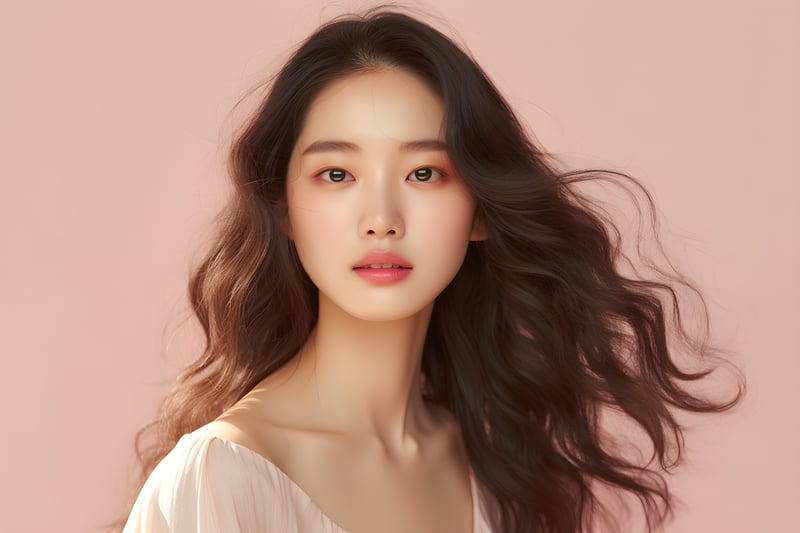
South Korea, home of the globally celebrated phenomenon in beauty and skincare products, called 'K-beauty', has carved a niche for itself in the beauty industry in the past few decades. This holistic approach to beauty includes skincare, makeup, and treatments, all of which are derived from innovative and sophisticated techniques that were developed to maintain beauty standards that were founded since the country's ancient times. K-beauty's effectiveness has won praise from all around the world, transcending from a mere trend to establishing its position as a mainstay of contemporary beauty regimens.
Download our 2023 Panel Book here
K-beauty's Historical Significance
South Korea, now one of the leading countries for producing sensational beauty products, is now on par with France, Italy, and other countries that have traditionally dominated the beauty industry. It is not the first time for South Korea to delve into beauty trends; it has a long history of developing its own beauty standard that is deeply rooted in its culture. The earliest record of South Korea's beauty culture may be found in the period of the three kingdoms (BC 37–668), three eras during which information and knowledge of beauty and skincare were passed on to the next and further advancements were implemented. In these periods, Koreans were known to utilize several skincare and makeup products, following detailed instructions on how to do one's makeup through a women's encyclopedia called the "Gyuhap Chongseo".
The beauty standard then focused on achieving a superficial appearance as it was associated with one's inner health and care. This awareness often flowed from the lower class to the elites. The generational cultivation of beauty standards has since become embedded in the nation's rich cultural heritage, evolving throughout the centuries into what is now a sophisticated and innovative outlook on beauty, characterized by its comprehensive skincare routines.
Today, this strong interest in physical attractiveness has become more prevalent. Walking in the streets of Seoul reveals the ongoing commitment to the nation's beauty culture as endless lines of advertisements fill the city ranging from cosmetic surgeries, skincare, and beauty products. It's also no surprise that South Korea is also known as the 'Cosmetic Surgery Capital of the World', having the highest number of surgeries per population, as nearly one in every four Koreans gets plastic surgery annually for both invasive and non-invasive surgeries. These surgeries focus more on the face compared to the United States, Brazil, and Greece, which also have high rates of annual cosmetic surgeries but with varied focuses.
However, while surgeries are focused on facial features South Koreans know well that beauty is all-encompassing. The country developed offerings in various ways to enhance one's beauty from head to toe. Salons for hair, body treatment, nail spas, and even color palette salons where you can have an in-depth analysis of what color suits you the best to better align your clothing with your skin tone is available. This strong commitment to self-improvement has drawn attention from around the world, leading to the introduction of K-beauty products.
Passion for Beauty
The societal level acceptance of enhancing and maintaining one's beauty at a collective level is a significant factor contributing to the continued passion and quest for beauty in South Korea. However, it is undeniable that this also puts pressure on everyone to conform. Similar to their historical counterparts, South Koreans have a strong belief that being physically attractive is key to having a more successful life, meeting a better partner, achieving career success, and more.
It is evident in every aspect of their lives; for instance, when applying for jobs in the country one must submit their photos along with their resume, as their appearance can have a disproportionate impact on the hiring process. Although like many beauty standards around the world are deemed unattainable, in South Korea many would go to great lengths to at least match the expectations set by society. This mindset is instilled from an early age when children are often given surgeries as graduation gifts by parents and regular visits to aestheticians, and routinely applying beauty and skincare products are common practices.
Ultimately this pressure on conformity to society's expectations led to the commodification of one's beauty and has become more accessible. Over time, as the country's name has become associated with luxury value many have aspired to attain its beauty products, turning South Korea's beauty industry into a global multi-billion phenomenon.
The Hallyu Effect
The global interest in anything Korean took shape in the 1990s in the wake of what the Chinese media called "Hallyu" which means "Korean wave". When the South Korean entertainment industry started to gain popularity mainly for its TV series, movies, pop music, and literature that captured the Asia-Pacific market, a trend that paved the way for the global exports of Korean products.
It was not until 2011 when the craze for the K-beauty industry began and became a hit in the West through the launch of BB cream, short for "Blemish Balm" a multi-tasking skincare product serving as a foundation, moisturizer, and sunscreen that was first a hit in South Korea and soon the sensation spread out in East and Southeast Asia. This focus on not only enhancing looks but also one's natural skin seemed to be a favorable approach for many who want to target two goals at once, to look good and to get better skin while doing their makeup.
A notable difference of K-beauty compared to other countries is its approach toward beauty. It prioritizes skincare even with its cosmetic products rather than piling up makeup. Arguably a healthier approach, to which Koreans implement a lengthy routine that usually involves layering when applying skincare or makeup to ensure the skin is well maintained. Ingredients of their products are usually composed of natural or organic ingredients that are usually hard to source in the West, These ingredients usually address multiple skin issues and combat aging. K-beauty is also used to fight aging signs such as wrinkles, and blemishes at a preventive stage or before its onset, unlike other beauty regimens where once these issues are visible is the only time they apply anti-aging products.
Over time this small yet strong beauty powerhouse steadily influenced the Western and neighboring Asian markets. By 2012 South Korea first recorded a cosmetic trade surplus of over KRW 100 billion (USD 87.9 million) and has since been increasing over the years together with Korean pop culture popularity, diversifying its export countries by 2019 from 137 countries to 160 countries. Increased overseas demand for the cosmetic trade surplus in 2020 reached KRW 7.92 trillion (USD 6.4 billion). By this time cosmetic products accounted for 14.3% of the country's combined USD 44.86 billion trade surplus, a quick rise from 13.6% in 2019.
However, like many industries affected by the pandemic in 2020 South Korea's momentum experienced a decline, the domestic cosmetic production dropped to 21.5% due to the decrease in demand. As a result, its foot traffic decreased significantly affecting its major sites such as Myeong-dong shopping street, a popular tourist destination in South Korea and considered as the mecca of K-beauty that collapsed due to a decrease in foot traffic.
Social media reignited interest in the K-beauty trend during the pandemic, however, consumption was focused on skincare as people also didn't have the chance to go out more, and wearing a mask prevented many from wearing makeup and instead focused on taking care of their skin through meticulous skincare routines and innovative products—the very core principles of K-beauty to achieve flawless, glass-like skin.
The dedication to achieving this coveted complexion is also still reflected in the local market of South Korea. A recent survey revealed by Standard Insights showed that the majority of Koreans have beauty shopping as part of their habit with 64% indulging every few months, and 16.4% are devoted and can't resist a monthly treat. Its robust economy (tenth largest in the world and fourth largest in Asia) consisting of an upper-middle per capita income (comparable to Italy) has allowed the consolidation of a high-spending middle class. While the global weight held by the country as a producing country has gradually grown, the country's ability to appreciate imported cosmetic products and goods has also increased.
Local consumers are significantly distinguished for their passion for beauty, personal care and constant attention to physical appearance as South Korea proves to be a receptive market for cosmetic products. In the survey Koreans' influential factor when it comes to buying their skincare or beauty products more than half of the respondents (52.4%) have said to seek top-notch quality. A report from export planning shows testifying proof of this, as distribution of imports in Korea demand for cosmetics that is strongly oriented toward high-quality products, highlighting a price range for the vast majority of the imported products are in the mid- to upper-mid-range, to which most premium price cosmetics are accounted for. This support of local consumers to import high-quality products is the very same attitude that has made K-beauty famous worldwide.
K-beauty also draws its strength from a particularly dynamic local market, where the competition is fierce and calls for a capacity for continuous innovation and speed to market. This is also present in other markets that they cater to. A comparison between Japan and South Korea, who both have brands that have taken the global stage, shows that while Japanese brands such as Shiseido have an overwhelming presence, South Korea's companies' major feature is that they tend to have a large number of retail outlets in their export markets. It is also obvious that South Korea is effectively using the attractiveness of its culture to promote the industry, leveraging a soft power through the emergence of influencers and its Korean pop culture particularly in the entertainment industry of music and K-drama.
Will the Beauty Standard hold up?
The grit and passion combined with fanatics for Korean entertainment have led to an increase in global exports. Today, it is undeniable that the rise of Korean beauty culture has influenced Western beauty culture as household names in the luxury market are introducing products that are inspired by the innovations and technologies introduced by K-beauty products and are collaborating with K-Pop idols to further touch the broader consumer base.
The consistent growth and continuous development through research, innovation, and technical advancement of K-beauty have also introduced subcultures within the market. By 2022, Male K-beauty have achieved its highest revenue expanding beyond basic maintenance as more males are becoming aware and embracing the connection between skincare, self-grooming, and wellness boosting the market further.
Companies in the K-beauty market are attuned to the changing consumer landscape, and how it has turned many consumers to be increasingly conscious of the products they purchase. In response, the beauty industry is now moving towards sustainability by incorporating recycled paper packaging materials and soy ink, while this shift may take some time to fully materialize. This movement reflects how modern-day consumers' heightened awareness and discernment. While the popularity of South Korean pop culture is still holding up and influencing millions worldwide, it's safe to say that it is not the only factor that will make these smarter and younger consumers stay; as they continue to seek products that offer tangible benefits not only for themselves but for their environment.
Learn more about South Korea and how it became the world's biggest luxury market here in Eye On Asia. You can also check out our educational blog post and learn the importance of Market Research in the beauty industry. See you in our next one!


 Download Panel Book
Download Panel Book


